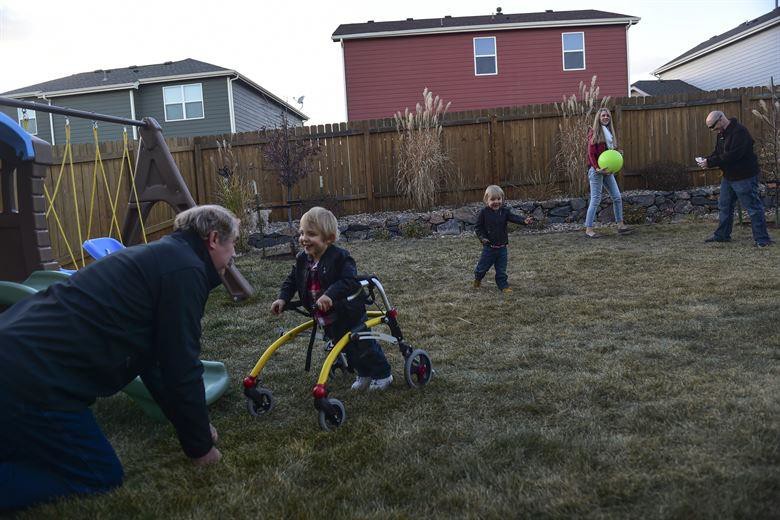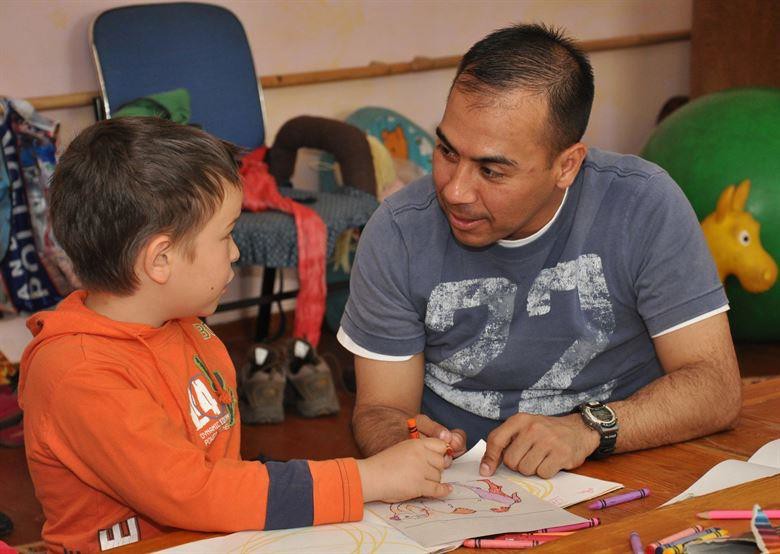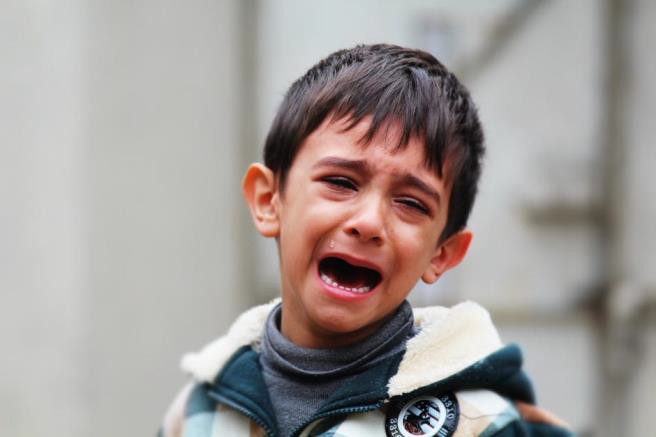70 Family Life
Relationships between parents and children continue to play a significant role in children’s development during early childhood. We will explore two models of parenting styles. Keep in mind that most parents do not follow any model completely. Real people tend to fall somewhere in between these styles. And sometimes parenting styles change from one child to the next or in times when the parent has more or less time and energy for parenting. Parenting styles can also be affected by concerns the parent has in other areas of his or her life. For example, parenting styles tend to become more authoritarian when parents are tired and perhaps more authoritative when they are more energetic. Sometimes parents seem to change their parenting approach when others are around, maybe because they become more self- conscious as parents or are concerned with giving others the impression that they are a “tough” parent or an “easy-going” parent. And of course, parenting styles may reflect the type of parenting someone saw modeled while growing up.

Baumrind
Baumrind (1971) offers a model of parenting that includes four styles. The first, authoritarian, is the traditional model of parenting in which parents make the rules and children are expected to be obedient. Baumrind suggests that authoritarian parents tend to place maturity demands on their children that are unreasonably high and tend to be aloof and distant. Consequently, children reared in this way may fear rather than respect their parents and, because their parents do not allow discussion, may take out their frustrations on safer targets-perhaps as bullies toward peers.
Permissive parenting involves holding expectations of children that are below what could be reasonably expected from them. Children are allowed to make their own rules and determine their own activities. Parents are warm and communicative, but provide little structure for their children. Children fail to learn self-discipline and may feel somewhat insecure because they do not know the limits.
Authoritative parenting involves being appropriately strict, reasonable, and affectionate. Parents allow negotiation where appropriate and discipline matches the severity of the offense. A popular parenting program that is offered in many school districts is called “Love and Logic” and reflects the authoritative or democratic style of parenting just described.
Uninvolved parents (also referred to as rejecting/neglecting) are disengaged from their children. They do not make demands on their children and are non-responsive. These children can suffer in school and in their relationships with their peers (Gecas & Self, 1991).
Video reviews Diana Baumrind’s four parenting styles.
Lemasters and Defrain
Lemasters and Defrain (1989) offer another model of parenting. This model is interesting because it looks more closely at the motivations of the parent and suggests that parenting styles are often designed to meet the psychological needs of the parent rather than the developmental needs of the child.
The martyr is a parent who will do anything for the child; even tasks that the child should do for himself or herself. All of the good deeds performed for the child, in the name of being a “good parent”, may be used later should the parent want to gain compliance from the child. If a child goes against the parent’s wishes, the parent can remind the child of all of the times the parent helped the child and evoke a feeling of guilt so that the child will do what the parent wants. The child learns to be dependent and manipulative as a result.
The pal is like the permissive parent described previously in Baumrind’s model. The pal wants to be the child’s friend. Perhaps the parent is lonely or perhaps the parent is trying to win a popularity contest against an ex-spouse. Pals let children do what they want and focus mostly on being entertaining and fun and set few limitations. Consequently, the child may have little self-discipline and may try to test limits with others.
The police officer/drill sergeant style of parenting is similar to the authoritarian parent described by Baumrind. The parent focuses primarily on making sure that the child is obedient and that the parent has full control of the child. Sometimes this can be taken to extreme by giving the child tasks that are really designed to check on their level of obedience. For example, the parent may require that the child fold the clothes and place items back in the drawer in a particular way. If not, the child might be scolded or punished for not doing things “right”. This type of parent has a very difficult time allowing the child to grow and learn to make decisions independently. And the child may have a lot of resentment toward the parent that is displaced on others.
The teacher-counselor parent is one who pays a lot of attention to expert advice on parenting and who believes that as long as all of the steps are followed, the parent can rear a perfect child. “What’s wrong with that?” you might ask. There are two major problems with this approach. First, the parent is taking all of the responsibility for the child’s behavior-at least indirectly. If the child has difficulty, the parent feels responsible and thinks that the solution lies in reading more advice and trying more diligently to follow that advice.
Parents can certainly influence children, but thinking that the parent is fully responsible for the child’s outcome is misguided. A parent can only do so much and can never have full control over the child. Another problem with this approach is that the child may get an unrealistic sense of the world and what can be expected from others. For example, if a teacher-counselor parent decides to help the child build self-esteem and has read that telling the child how special he or she is or how important it is to compliment the child on a job well done, the parent may convey the message that everything the child does is exceptional or extraordinary. A child may come to expect that all of his efforts warrant praise and in the real world, this is not something one can expect. Perhaps children get more of a sense of pride from assessing their own performance than from having others praise their efforts.

So what is left? Lemasters and Defrain (1989) suggest that the athletic coach style of parenting is best. Before you draw conclusions here, set aside any negative experiences you may have had with coaches in the past. The principles of coaching are what are important to Lemasters and Defrain. A coach helps players form strategies, supports their efforts, gives feedback on what went right and what went wrong, and stands at the sideline while the players perform. Coaches and referees make sure that the rules of the game are followed and that all players adhere to those rules. Similarly, the athletic coach as parent helps the child understand what needs to happen in certain situations whether in friendships, school, or home life, and encourages and advises the child about how to manage these situations. The parent does not intervene or do things for the child. Their role is to provide guidance while the child learns firsthand how to handle these situations. And the rules for behavior are consistent and objective and presented in that way. So, a child who is late for dinner might hear the parent respond in this way, “Dinner was at six o’clock.” Rather than, “You know good and well that we always eat at six. If you expect me to get up and make something for you now, you have got another thing coming! Just who do you think you are showing up late and looking for food? You’re grounded until further notice!”
The most important thing to remember about parenting is that you can be a better, more objective parent when you are directing your actions toward the child’s needs and while considering what they can reasonably be expected to do at their stage of development.
Parenting is more difficult when you are tired and have psychological needs that interfere with the relationship. Some of the best advice for parents is to try not to take the child’s actions personally and be as objective as possible.
Cultural Influences on Parenting Styles
The impact of class and culture cannot be ignored when examining parenting styles. The two models of parenting described above assume that authoritative and athletic coaching styles are best because they are designed to help the parent raise a child who is independent, self-reliant and responsible. These are qualities favored in “individualistic” cultures such as the United States, particularly by the white middle class. African-American, Hispanic and Asian parents tend to be more authoritarian than non-Hispanic whites.

In “collectivistic” cultures such as China or Korea, being obedient and compliant are favored behaviors. Authoritarian parenting has been used historically and reflects cultural need for children to do as they are told. In societies where family members’ cooperation is necessary for survival, as in the case of raising crops, rearing children who are independent and who strive to be on their own makes no sense. But in an economy based on being mobile in order to find jobs and where one’s earnings are based on education, raising a child to be independent is very important.
Working class parents are more likely than middle class parents to focus on obedience and honesty when raising their children. In a classic study on social class and parenting styles called Class and Conformity, Kohn (1977) explains that parents tend to emphasize qualities that are needed for their own survival when parenting their children. Working class parents are rewarded for being obedient, reliable, and honest in their jobs. They are not paid to be independent or to question the management; rather, they move up and are considered good employees if they show up on time, do their work as they are told, and can be counted on by their employers. Consequently, these parents reward honesty and obedience in their children.
Middle class parents who work as professionals are rewarded for taking initiative, being self- directed, and assertive in their jobs. They are required to get the job done without being told exactly what to do. They are asked to be innovative and to work independently. These parents encourage their children to have those qualities as well by rewarding independence and self- reliance. Parenting styles can reflect many elements of culture.[1]
In this video, Dr. Boise reviews the definition of parenting style, Lemasters and Defrains’ parenting styles, and how context can be related to the frequency and impact of parenting styles.
Spanking
Many adults can remember being spanked as a child. This method of discipline continues to be endorsed by the majority of parents (Smith, 2012). Just how effective is spanking, however, and are there any negative consequences? After reviewing the research, Smith (2012) states “many studies have shown that physical punishment, including spanking, hitting and other means of causing pain, can lead to increased aggression, antisocial behavior, physical injury and mental health problems for children” (p. 60).

Gershoff, (2008) reviewed decades of research and recommended that parents and caregivers make every effort to avoid physical punishment and called for the banning of physical discipline in all U.S. schools. Gershoff and Grogan-Kaylor (2016) completed another metanalysis that looked at research over 160,927 children . They found increased risk for negative outcomes for children who are spanked and that effects of spanking were similar to that of physical abuse.
In a longitudinal study that followed more than 1500 families from 20 U.S. cities, parents’ reports of spanking were assessed at ages three and five (MacKenzie, Nicklas, Waldfogel, & Brooks-Gunn, 2013). Measures of externalizing behavior (aggression and rule-breaking) and receptive vocabulary were assessed at age nine.
Overall, 57% of mothers and 40% of fathers engaged in spanking when children were age 3, and 52% of mothers and 33% of fathers engaged in spanking at age 5. Maternal spanking at age 5, even at low levels, was associated with higher levels of aggression at age 9, even after an array of risks and earlier child behavior were controlled for. Father’s high-frequency spanking at age 5 was associated with lower child receptive vocabulary scores at age 9. This study revealed the negative cognitive effects of spanking in addition to the increase in aggressive behavior.
Internationally, physical discipline is increasingly being viewed as a violation of children’s human rights. Thirty countries have banned the use of physical punishment, and the United Nations Committee on the Rights of the Child (2014) called physical punishment “legalized violence against children” and advocated that physical punishment be eliminated in all settings.
Alternatives to spanking are advocated by child development specialists and include:
- Praising and modeling appropriate behavior
- Providing time-outs for inappropriate behavior
- Giving choices
- Helping the child identify emotions and learning to calm down
- Ignoring small annoyances
- Withdrawing privileges[2]
- Lifespan Development - Module 5: Early Childhood by Lumen Learning references Psyc 200 Lifespan Psychology by Laura Overstreet, licensed under CC BY 4.0; ↵
- Child Growth and Development by Jennifer Paris, Antoinette Ricardo, & Dawn Rymond licensed under CC BY 4.0 ↵

